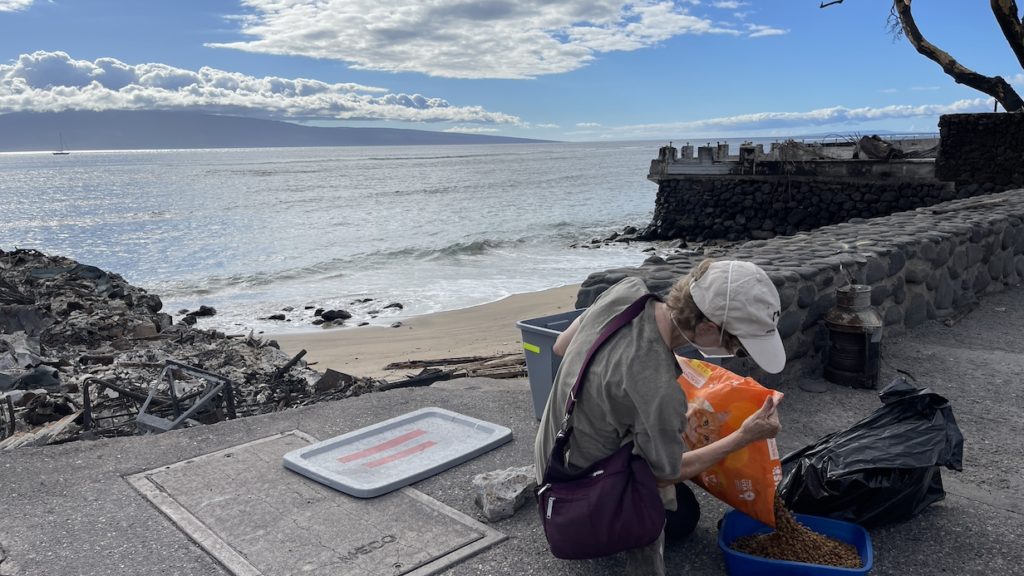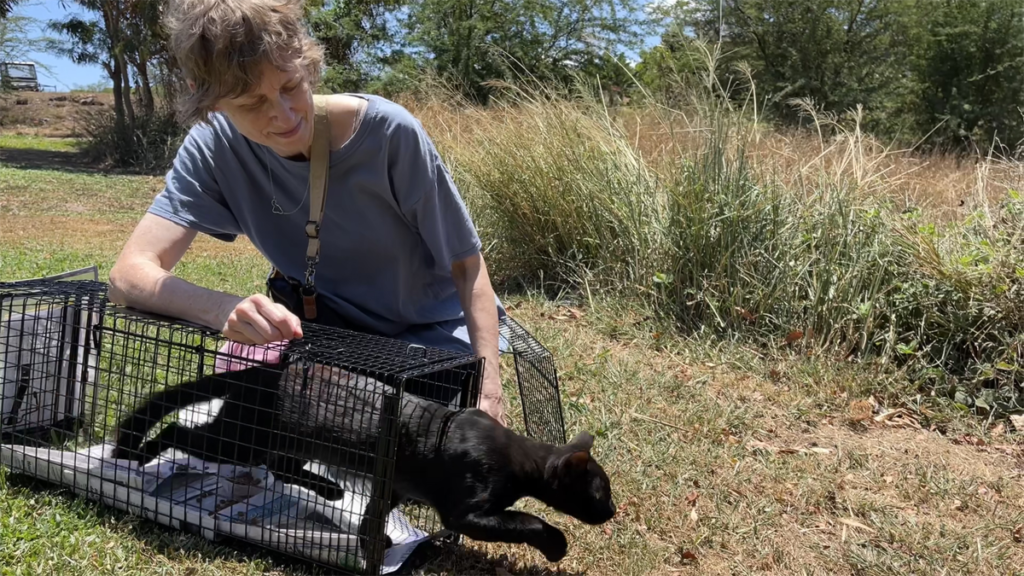
Our Cat Person of the Month for November is TNR Pioneer Susan Richmond.
Neighborhood Cats’ mission is simple: its goal is to improve the lives of cats living outdoors, wherever they may be, and to support the compassionate people caring for them. Since 1999 the organization has promoted the method known as Trap-Neuter-Return (TNR) to most effectively and humanely manage free-roaming cat populations.
Over the years Neighborhood Cats developed and advanced many of the practices now commonly used in the field, even co-designing the first commercially available drop trap. They also worked to promote mass trapping of cat colonies and developed CatStats, a user-friendly online colony database for TNR programs.
Today, Neighborhood Cats continues to work with cat colony caretakers, shelters, clinics, municipalities, and communities at large to promote outdoor cat welfare. Their TNR certification workshops, hosted by the Community Cats Podcast and presented online monthly, reach a global audience and have trained thousands of participants in best TNR practices and strategies.
Meet our Cat Person of the Month, Susan Richmond, Executive Director of Neighborhood Cats. Susan lives in south Maui, Hawaii. On August 8, 2023, the worst wildfire in the state’s history destroyed most of the historic town of Lahaina on the island’s west side. Nearly 100 people perished in the disaster and countless animals’ lives were lost. Neighborhood Cats is now leading efforts to care for and trap cats who survived and are still living in the 5.5 square mile burn zone.
Mewla Young: Susan, we are honored to have you with us today! First of all, our hearts go out to you and others on Maui who have experienced or been close to such a massive disaster. We know of the terrible losses as well as the strength of the community to come together and begin to recover. The Maui Humane Society and Neighborhood Cats have helped to save so many animals, and I know that has only happened because of your tireless day-to-day work on the ground.
What has it been like to be immersed in rescue efforts at a time when communities are still reeling from grief and tragedy?
Susan: Everyone has seen the images on the news and has a sense of how massive the fires were. But until you’re actually there, inside the burn zone, it’s impossible to really comprehend the scope of the tragedy. Lahaina was a beautiful, historic town and now…there’s just nothing left. Miles of rubble, ashes, and twisted metal where there were homes, families, and so much life. When we were finally allowed into the restricted area, it was shocking to see. But we knew there were cats who’d survived and needed medical attention and other care urgently, so we had to put everything aside and get to work.
One of the most surprising things that happened was that, as we looked for volunteers to help bring food and water to the cats each day, people whose homes had been demolished in the fire stepped forward to join us. These folks were living in emergency housing, they’d just lost everything they owned but they wanted to be part of helping their community heal. In the midst of so much devastation, that was, and is, truly inspiring.

Mewla: The compassion the people of Maui have shown is a testament to the community’s spirit and resilience. It’s amazing to hear that, despite unimaginable losses, the people came forward to help with trapping and rescue.
Have you been able to trap cats that ended up being pets who were reunited with their humans?
Susan: Yes! Among the cats we’ve helped remove from the burn zone so far, there have actually been at least two dozen happy reunions with families. One of them, a tabby named Babe, had been reported missing by his dad the day after the fire. The gentleman had lost his home, his car, everything but all he cared about was finding Babe. It took several weeks before Babe was located and the owner cried when he got the phone call that his boy was alive and waiting for him at the shelter. That’s the sort of outcome that keeps us all going!
Mewla: Stories like that just bring tears to my eyes. We know how much humans and pet cats will be able to help each other heal after this tragic event. I hope that humans whose pets may have died in the fire will consider adopting new pets who need a home and a person to love.
Charities helped pay for some homeless pets to be flown to the mainland USA for adoption. Because of significant dangers throughout the burn zone, the surviving cats will need to be moved out, including all the feral cats. Are there specific resources you still need?
Susan: Neighborhood Cats is working closely with Maui Humane Society to rescue cats impacted by the fire. It turns out, far more cats made it through than anyone initially thought possible. Several hundred are estimated to have survived. Because many of them have lived outdoors all their lives, and aren’t all that used to close contact with people, they won’t be able to be put up for adoption. But they can’t stay where they are, either; there will be massive reconstruction going on throughout Lahaina for a long time to come, and conditions will be too unsafe.

So we’re working on a plan now, to provide catios for folks who are willing to take in two or more displaced cats. “Catios” are screened enclosures that are used to keep cats safe outdoors. Anyone willing to give a home to kitty survivors would only have to keep them in the catio for 30 days; after that, the cats will have acclimated to their new territory and can be released.
We’re fortunate to have funding ready to provide catios. What we need now are people in the Hawaii community who are willing to open their homes and hearts to these cats by placing a catio on their property, and helping the cats start over.
Mewla: Providing residents a concrete means to help by providing catios is a great idea! Everyone has really come together.
We read about the delays you experienced waiting to get in and help cats in the restricted zone. The Maui government did seem to weigh the role of harm in their decision, but the delays were excruciating. Are there any changes that you’d like to see regarding the government’s role in managing community cats?
Susan: On a long-term basis, we’d love to see more funding for TNR. The more accessible we can make spay/neuter care, the better! Recognition that those practicing Trap-Neuter-Return are actually performing a service that benefits the entire community would also be helpful.
Mewla: It seems like the message that Trap-Neuter-Return benefits the entire community is slowly getting out. What have you found to be the most rewarding aspect of your work in TNR?
Susan: For a long time, unsocialized cats living outdoors were pretty much invisible. Of course, there have always been kind individuals who’ve fed the cats in their backyards and neighborhoods. These people have done their best to help the cats, but on a community-wide level, there was nothing. No accommodations in shelter systems and no funding for veterinary care.
That’s changed dramatically over the past couple of decades and now, TNR is widely known and accepted. Advances that were unthinkable just a few years ago are now commonplace – for example, more and more shelters have Community Cat Coordinators to address the unique needs of these cats and how they interact with their human neighbors. Being part of that movement, that change for the better for these once-forgotten souls is immensely rewarding.
Mewla: That is wonderful news. And I know that Neighborhood Cats and similar organizations have worked tirelessly to help make that change take place. We so appreciate everything you do to help humans understand how to co-exist with community cats.
I have one last question for you. When did you first fall in love with cats, and what was it that made you fall in love with them?
Susan: That’s kind of like asking when did you first start breathing? I’ve always loved cats…and dogs, and horses and llamas and turtles – and on and on! I was always the kid who brought home strays and begged to keep them. That was never well-received and I didn’t actually get my first cat until I was 13. Her name was Poppie. She was just a tiny scrap of orange and white fuzz when we met and she was magical. I loved her big, coppery eyes that always looked so wise in her little kitten face. I loved her quiet purr and the way she’d sink into my lap, making a bad day at school melt away. She’s been gone a long time now but I still miss her dearly. And I still find something magical and wise about every cat I’m lucky enough to meet.
Mewla: OMGosh, Poppie sounds like an angel, magical and wise for sure. Thank you so much for sharing with us today, Susan, and for all you do to help neighborhood cats!
*For more information about helping cats in the community and for TNR resources, make sure you visit Neighborhood Cats at: https://www.neighborhoodcats.org/
*Neighborhood Cats is also on Facebook
*Susan Richmond is also a co-author of “The Return to Field Handbook” (published by The Humane Society of the United States, 2019). The handbook is a valuable how-to for Return-To-Field programs that describes everything from gathering information and assessing eligibility to program staffing, veterinary care, and returning a cat to the community. You can download the handbook for free and find other resources at https://www.neighborhoodcats.org/resources/books-guides
Special note: We send our thoughts and support to those impacted by disaster or war and especially to those who lost human or animal loved ones. Resources for dealing with the grief of losing a pet can be found at Pet Loss Grief (https://resources.bestfriends.org/article/grieving-loss-pet-resources-coping).
Please leave your comments or questions about
the Susan Richmond/Neighborhood Cats article below.



Congratulations to my cousin Susie Richmond! I can attest that Susie has loved and cared for animals since she was a little girl and would come to visit us on the farm. Who knew she would make a career of her kind passion!
Thanks so much for sharing! We hope others will follow and also put their passion into action. : )
Congratulations Susan! Outstanding work in a time of crisis. Been a long time since SU, right?
We remember you and your amazing work in Brooklyn, Susan! You remain a great inspiration to us!
All the very best,
Petr & Jeanne
“Anyone who saves a life is as if he saved an entire world.” Thank you Susan, and all your collaborators and contributors, for saving these very precious lives.
Congratulations Susan and God bless!
Well deserved accolade!
What a horrible disaster! My heart goes out to the people and animals who had to go through that. Susan Richmond has done admirable work for the cats, and the people also. Having been through a serious disaster ourselves, an EF-4 tornado, we know that those who come to help deserve enormous appreciation! Great post, Mewla!
Thank you so much, Leah.
What wonderful acts to help the cats survive and receive medical attention. God bless you!
Wonderful, for sure : )
As I read parts of the interview, my eyes watered up. I was deeply concerned about all who lost friends and relatives in Lahaina. My heart was broken to see such devastation and losses and I often thought about the fur children. These are the victims often overlooked in such trying times. A wall of strong emotion came upon me as I read about Susan’s hard work in rescuing, returning and helping to care for these little ones. The story about Babe brought cleansing tears….there are no words to describe the heros of Lahaina. They are luminous beings full of light. Susan is one of them and she has my deepest love and respect. What a beautiful, compassionate human being.🩷 Thank you for sharing this amazing story of courage, strength and divinely inspired devotion.
Thank you, Celinne.
Congratulations Ms. Richmond on your well-deserved title. Your profound love for cats shows in your every word. Thank you for your work with these defenseless fire victims.
Thank you, DR.
Susan(Susie to us) is my first cousin. From the time I first met her as a child, (she and her family would visit us on our dairy farm in upstate NY.), Susie would make a beeline for the barn cats and whatever other animals she could get her hands on from the minute they drove in the driveway! Congrats, Susie-well-deserved!
Nathena, Thank goodness for cat lovers/advocates like Susan! We appreciate your comment.
Congratulations Susan Richmond! The cats on Maui are so lucky to have you. You been through terrible disaster and truly are a gift from heaven to put the needs of the cats before your own! And thank you Mewla for this excellent article!
Thank you, too.